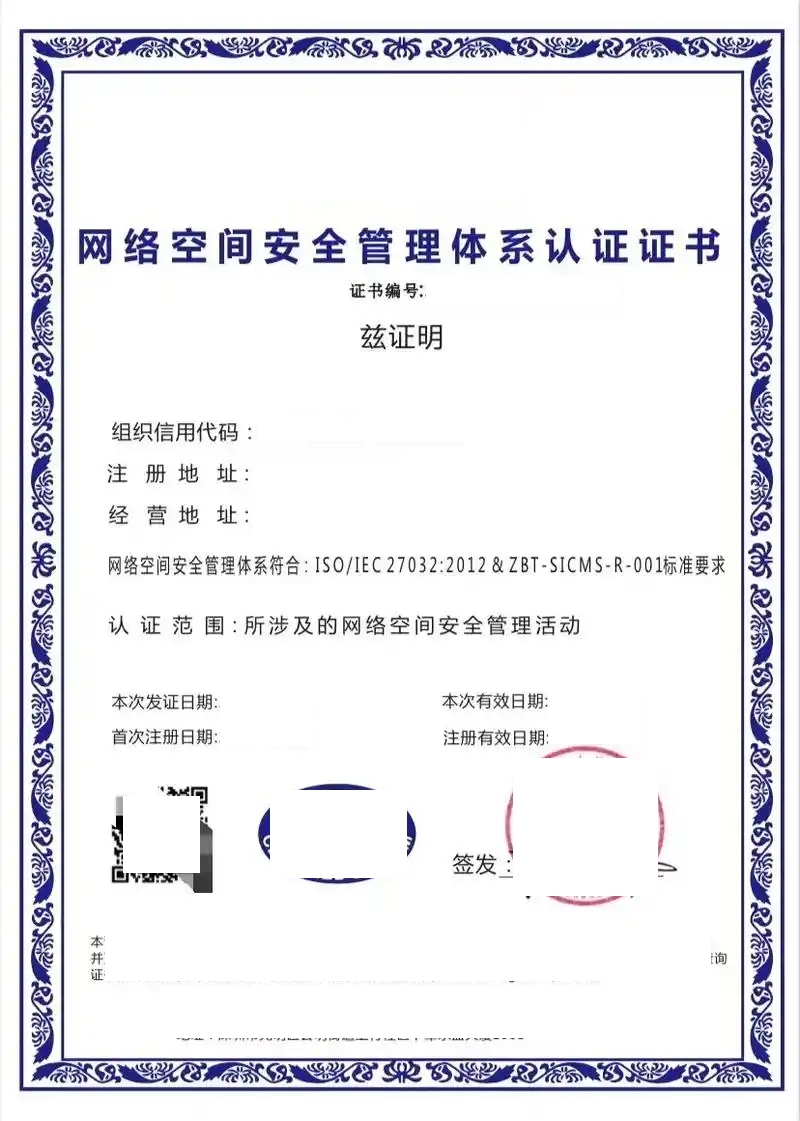
 Professional services are guaranteed
Professional services are guaranteed One on one full process guidance
One on one full process guidance Efficient and fast experience
Efficient and fast experienceISO/IEC 27032 is the first international standard focused on Cyberspace Security, aimed at addressing cross domain security challenges that are difficult to cover with traditional information security standards such as ISO 27001. Its core goal is to achieve trustworthy identity, controllable behavior, and data availability of "entities" (such as individuals, enterprises, and governments) in cyberspace through multi-party collaboration mechanisms.
Applicable scenarios:
• Cross industry and cross organizational threat intelligence sharing and collaborative defense
• Security responsibility allocation in emerging technology scenarios such as cloud computing and the Internet of Things
• Security governance of National Critical Information Infrastructure (CII)
• Cybercrime Prevention and Event Response
Standard features:
• Systematic: covering multidimensional security elements such as technology, management, and law.
• Collaboration: Emphasize the joint participation of public and private sectors, technology communities, and users.
• Dynamics: Adapt to the rapid evolution of network threats and support continuous improvement.
ISO/IEC 27032 has developed a model centered around the Cyberspace Security Governance Framework (CSCG), which includes the following key elements:
The Four Pillars of Cyberspace Security
Technical security: including basic protection measures such as encryption, access control, vulnerability management, etc.
Organizational security: Achieving endogenous security through policy formulation, risk management, and personnel training.
Physical security: Protecting the physical facilities that support cyberspace, such as data centers and communication links.
Social engineering defense: prevention strategies against phishing attacks and social engineering threats.
2. Six core principles
Identity authentication: Ensure the authenticity and uniqueness of the identity of network entities.
Behavior traceability: anomaly detection is achieved through log auditing and behavior analysis.
Data integrity: prevent data tampering and unauthorized leakage.
Threat Intelligence Sharing: Establish a cross organizational threat information exchange mechanism.
Elastic architecture: Design network systems with fault tolerance and fast recovery capabilities.
Compliance adaptation: Coordinated implementation with laws and regulations such as GDPR and cybersecurity laws.
1. Enhance organizational resilience
Reduce financial and reputational losses caused by data breaches and service interruptions (according to IBM's 2023 Data Breach Cost Report, the global average cost per breach is $4.45 million).
Meet the compliance requirements of global data privacy regulations such as GDPR and CCPA.
2. Promote ecological cooperation
Enhance supply chain trust through standardized security practices and attract partners with high compliance requirements.
Support cross-border business expansion and reduce operational risks caused by regional differences in security standards.
3. Enhance market competitiveness
Obtaining ISO/IEC 27032 certification can serve as an authoritative endorsement of a company's security capabilities, enhancing customer confidence.
Suitable for highly regulated industries such as finance, healthcare, and energy, helping enterprises win bidding advantages.
(I.) Implementation conditions
1. Organizational basic requirements
Management commitment: Senior management needs to clearly support cybersecurity goals and allocate resources (budget, personnel, technology).
Existing security management foundation: It is recommended to have preliminary practice of information security management system (such as ISO 27001) or network security framework (such as NIST CSF).
2. Collaboration ability
Stakeholder participation mechanism: Network security collaboration relationships (such as threat intelligence sharing agreements) need to be established with suppliers, customers, regulatory authorities, etc.
3. Compliance and adaptability
Regulatory and industry requirements: Must comply with the network security regulations (such as China's Cybersecurity Law, EU GDPR) and industry-specific standards (such as PCI DSS for the financial industry) in the region where the business is located.
(II.) Core application materials
If compliance assessment needs to be conducted through a third-party organization, the following materials need to be prepared (adjusted according to the requirements of the assessment organization):
1. System documents
Cybersecurity Policy: Clarify the organization's commitment, goals, and division of responsibilities for cybersecurity.
Risk assessment report: Based on the threat analysis method of ISO/IEC 27032, identify key assets, vulnerabilities, and risk levels.
Control measures document: Technical and management control checklist (such as encryption policy, incident response plan, third-party security management process).
2. Implement evidence
Collaboration agreement: Records of secure cooperation with external stakeholders (such as data sharing agreements, joint exercise reports).
Technical deployment proof: Security tool configuration records (such as firewall logs, intrusion detection system operation reports).
Training records: Employee network security awareness training plan, drill records, and assessment results.
3. Operation and improvement records
Internal audit report: Results of regular checks on the effectiveness of the system and improvement measures.
Event response record: Historical network security event handling report (such as attack response, recovery process).
Continuous improvement plan: an optimization plan based on the PDCA cycle (such as technology upgrades and process iterations).
(III.) Key precautions
1. Integration with ISO 27001
If ISO 27001 certification has been obtained, its control measures (such as A.15 "Supplier Relations") can be directly extended to reduce implementation complexity.
2. Dynamic adaptability
It is necessary to regularly update risk assessments and control measures to address new threats, such as AI driven attacks.
3. Cost and cycle
The implementation cycle usually takes 6-12 months, and the cost depends on the size of the organization and the current security situation.
(I.) Preparation in advance
Understanding standards: Enterprises need to delve into the requirements and content of ISO/IEC 27032 standard, clarify its specific provisions for network security management system, and ensure that subsequent system construction complies with the standards.
Establish a system: Based on the requirements of ISO/IEC 27032 standard and combined with the actual situation of the enterprise, establish a network security management system that covers multiple aspects such as risk management, personnel training, and technical protection.
System operation: Put the established network security management system into practice, ensure that all measures are effectively implemented, and run for at least three months, generating corresponding operation records to prove the effectiveness and compliance of the system.
(II.) Certification application
Submit application: When the enterprise's network security management system construction reaches a certain level, submit a certification application to the certification body, provide necessary enterprise information and records, and pay the corresponding certification fees.
Contract signing: The certification body conducts a preliminary evaluation of the application, and if it meets the requirements, both parties sign a certification contract to clarify their respective rights and obligations.
(III.) Review phase
Pre evaluation (optional): Certification bodies can conduct pre evaluation to help companies identify problems in the system in advance, so that they can make timely improvements and improve the pass rate of formal audits.
On site audit: The certification body dispatches an audit team to conduct an on-site audit of the enterprise's network security management system. The audit content includes reviewing the organization's management system, evaluating the organization's cybersecurity capabilities, and assessing the organization's risk management situation.
(IV.) Result processing
Corrective measures: If the certification body discovers any non conformities or issues during the audit process, the enterprise needs to take corrective measures and make improvements until the certification standards are met.
Certificate issuance: When the certification body considers that the enterprise has met the certification requirements, it will issue the ISO/IEC 27032 Network Space Security Management System Certification, which is valid for three years.
(V) Continuous monitoring
Annual supervision and audit: During the validity period of the certificate, the enterprise needs to undergo an annual supervision and audit to ensure the continued effectiveness of its network security management system.




Wechat ID:Siterui888888
Add a wechat friend to get free plans and quotations


 Contact
Contact




 定制化解决方案
定制化解决方案 专业咨询指导
专业咨询指导 透明化服务
透明化服务 长期顾问式合作
长期顾问式合作